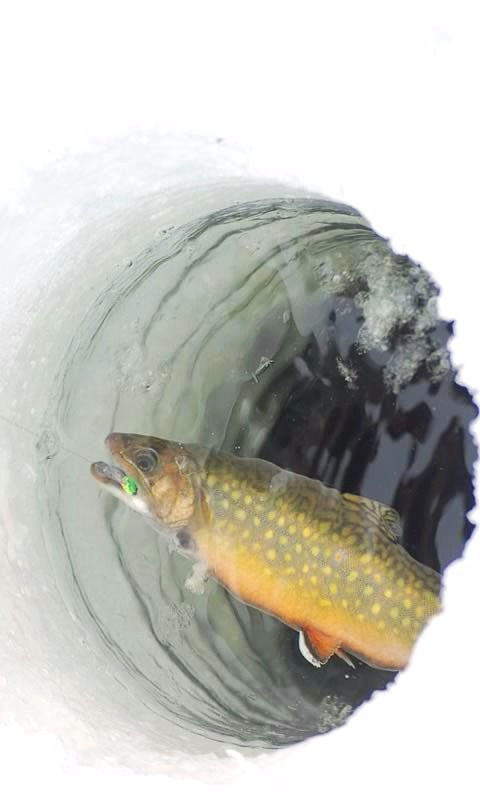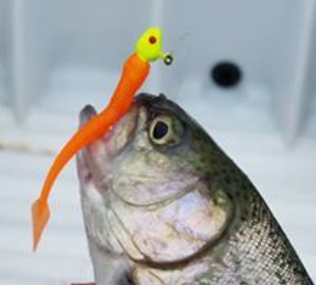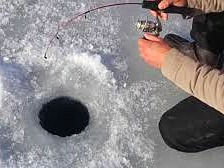
Rainbow trout, brooke trout, brown trout, and golden trout are active feeders under the ice. Aggressive fish are attracted to movement, which makes Freaky Frank's freaky worm an excellent choice for ice fishing. Frozen lakes, ponds, or mouths of tributaries provide opportunities for fisherman to capitalize on catching trout.
Trip Planning
Check the weather conditions, weather can make driving to your fishing location difficult but the fishing action is worth the drive. Visit the Division of Natural Resources for the latest trout stocking and choose a location from the stocked list. Lake maps are valuable resources for finding depth, structure, and under water points.
Finding a Trout Fishing Spot
Upon arriving at the location for the first time it can be difficult to find a productive fishing hole. Choosing a spot depends on the species of trout that are stocked. Every species of trout school differently according to structure, depth, and water temperature. Rainbow trout and golden trout are an open water schooling species. Fish for rainbows towards the middle of the lake, off of sharp breaks, or under water points near the middle of the lake. Brooke trout and brown trout school around structure. Schools of trout move around and its important to keep moving until you find the fish and establish a depth or structure pattern. Electronics is another useful method for locating fish, either by viewing the fish or locating structure. Using existing fishing holes can be productive.
Jig Fishing Method

Once a location has been found, start by drilling two holes about 6 to 8 feet apart. The first hole, rig a rod using a freaky worm on a 1/32 ounce jig head (like pictured) under a small bobber with the jig about three to four feet under the bobber, spray the worm with Frank's Trout Sauce. Drop the rig into the hole and prop up the rod. Watch the bobber while you fish the adjacent hole. The reason for this is that some trout like to cruise just under the ice. Rig the second rod with a 1/32 ounce jig head with a freaky worm and a small BB weight next to the head of the jig head, spray with Frank's Trout Sauce. Next drop the shimmy worm down the hole to the bottom, then pull the line up about two feet and place a small peg bobber on the line. Place the bobber in the water and it should sink slowly, adjust BB weights next to the jig head until the bobber is sinking slowly under the water. Jigging the freaky worm up off the bottom with a twitching method (no need to reel) until the bobber gets to the top of the water, then allow the bobber to fall slowly back until the bait hits the bottom (when the bobber stops the bait is on the bottom). "Trigger their aggression" by twitching the rod tip which intensifies the movement of the freaky worm's tail that trout just can't resist. Repeat for 10 to 20 minutes and if there isn't any action move locations. Change colors throughout the day until the trout consistently bite a color. From experience smoke hole white, boom boom pink, and buffalo orange are the colors that preform the best.
If trout are biting on top, then move both poles to the top. If fish are on the bottom use a slip bobber on the first rod and move the freaky worm just up off the bottom. Flurries of strikes come when the school has been located or passing through. If fish are being finicky add an additional spray of Frank's Trout Sauce and tip the hook with a wax or meal worm. By employing these two different fishing methods a pattern can be established and repeated to put more fish on the ice.
Fighting Trout & Ice

Trout just can't resist the Freaky Frank's freaky worm. When the bobber moves left, right, or down under the water, this indicates a strike. After setting-the-hook, the drag should be adjusted depending on the strength of line and how hard the trout is fighting. Before starting to reel take the peg bobber off of the line. A large trout can break the line by rubbing the edge of the ice. If the fish is rubbing the line on the ice, to prevent the line from breaking, keep constant pressure on the fish by reeling and putting the rod tip under the ice. When the trout surfaces it is easy to swing a small trout onto the ice. A large trout may require the use of hands to lip, slide a finger under the gill plate, or grab the trout by its side. Once the trout is on the ice, it's time to get back in the water after another fish while the school is around.
Conclusion
Fishing Freaky Frank's freaky worm in combination with these tactics will put more trout on the ice. Plan the fishing trip according to DNR stocking and weather. Dress warm, wear gloves, take a heater, and put time in on the ice. When you fish with Freaky Frank's, fish with confidence, the trout will bite just got to find the school. The best part about trout ice fishing is that they bite all day.
Change the way you fish!

This blog will make catching fall brood trout easy. The weather, stock truck, and water conditions are variables that can be difficult to predict. This article highlights some strategies we use in the fall that will land brood trout in your boat.
The single most important part of catching brood trout is fishing where they exist. First find bodies of water that are logging citations for brood trout. This can be found on state DNR websites. Next, if you are in a state that stocks trout look at the stock report. For the best opportunity to catch fish I recommend fishing a body of water that has been stocked in the same week you plan on fishing.
The weather needs to be taken into consideration, because water temperature is a direct reflection of the weather. Trout are sensitive to the water temperature and bite better in warm temperatures at dawn and dusk, but bite best at 50-60 degrees. In cold weather the trout bite slow but bite better towards the middle of the day. Sunshine warms the water temp with cold temps and move the trout up in the water column but moves the trout down in the water column in warm water. Cloudy days are good when the water temp is warm because fish bite longer and stay up in the water column, but if the water temp is cold the clouds prevent the water from warming and the trout stay lower in the water column. If the weather is cold adjust the shimmy worm to where its close to the bottom of the lake or stream. You should adjust your bobber to the depth of the trout, a fish finder really helps locate the depth of the fish. Wind also moves the trout towards the direction it's blowing. Wind can positively and negatively affect your fishing. Negatively, the wind makes it hard to jig the freaky worm. Wind can help if the trout are biting slow and want the freaky worm on the sit. Wind can cool off the top of the water and move the fish lower in the water column.
Trout are a competitive schooling fish that a fisherman can score by using the correct bait/technique and using the weather, stocking, water conditions, and time of day to their advantage. When you get to the lake look for fish surfacing and move to that spot. Surfacing fish usually indicates a school of trout. In the fall the trout like the head of lakes or tributaries because they are trying to spawn.
Species of trout stage in different areas of the lake or stream. If you are fishing for rainbow trout they like to school and suspend in the open water. In a stream fish for rainbow's in the current lines next to slack water at the top or bottom of the hole. Brooke and brown trout like structure (trees or rocks) and hang near the bottom of the stream or lake. Golden trout good luck getting them to bite.
Now that you have found the trout it's time to use the correct technique. Standard trout fishing setup is a ten foot rod (this allows you to jig easier, increases hook percentage, allows big fish to go on runs without breaking the line), 4 pound test fluorocarbon line, 1 inch cigar bobber, Freaky Frank's Trout Sauce, and a 1/32 ounce jig head. If the water is cold fish the freaky worm deep under the bobber 7 to 10 feet. Trout seem to like the worm jigged slow or on the sit in cold water temps or if the water is choppy. If the water is warm, fish the shimmy worm 3 to 4 foot under the bobber and trigger their aggression by using the jigging technique demonstrated on Freaky Frank's Custom Tackle YouTube or Facebook page. Try different jigging methods and speeds to see what the trout want. Once you find the speed and technique to catch a trout throw back in the same spot because more than likely you have found a school.
The freaky wormis a superior trout worm that "fish just can't resist," and with these proven techniques you will catch more fish.

Catching hand size gills can be challenging, but not if a fisherman has a fertile bluegill fishing spot, prime time of year and day, fishing technique, and most importantly the bait. The best time to fish for bluegills is in the late spring while the bass are spawning and the crappie bite has slowed. They are found in the shallow areas around mud flats, wood, and rocks. The freaky worm is an excellent choice of bait to trigger bluegill's aggression. I recommend using a 1/32 ounce jig head (hook the worm through the nose and the point of the hook should come out the smooth part of the body- worm should be straight- (this is important for the action!) under a 1" cigar bobber. Cast the freaky worm and bobber into a prime location, allow time for the jig head to sink and the bobber to tip up straight. Now its time to start jigging the bobber by slowly twitching the rod tip while reeling in the slack. Jig the bait 2 to 4 feet and stop (allow the bait time to fall to the bottom- when bait falls to bottom of line the bobber will tip up). Most fish strike when the bobber stops and sets for a few seconds. Repeat the action until the bait is out of the prime fishing zone. If the gills are not sinking the bobber add Franky Frank's Crappie Sauce. With this scent, the fish won't let go, which increases your hook-ability. Boom boom pink, Buffalo orange, mossback, and smoke hole white freaky worms will increase the amount of hand size gills you catch.



























